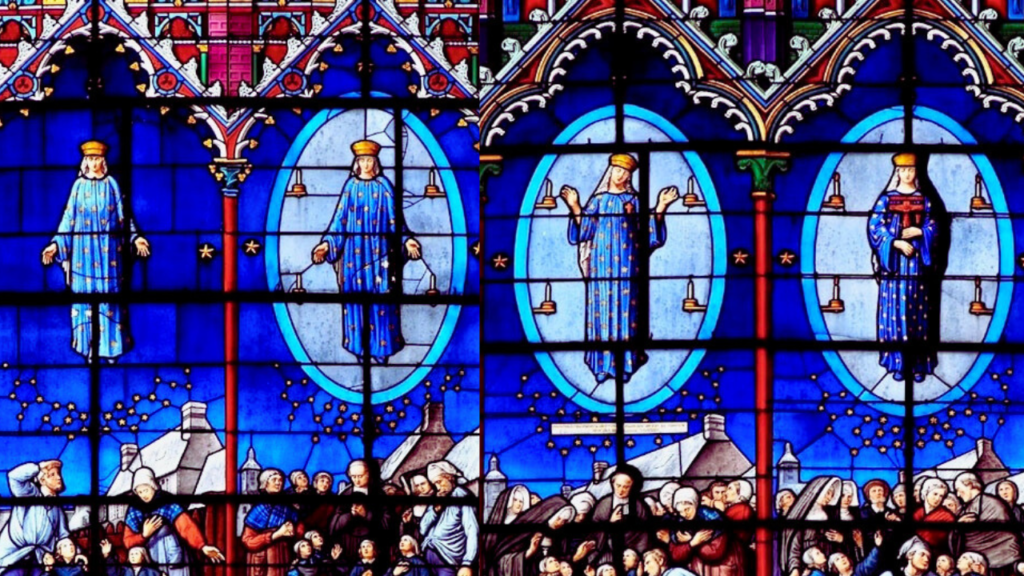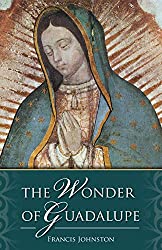
CJS.Org Introductory Remarks
This is the third and concluding part of a highly detailed, well-researched narrative of the Apparition of Our Lady of Pontmain. This is taken from Bernard St John’s 1903 book The Blessed Virgin in the Nineteenth Century: Apparitions, Revelations, Graces.
There are three parts to this series:
Part 1 The Apparition of the Virgin
Part II – The Blessed Virgin Brings a Message to Catholic France
Part III – A Crucifix the Colour of Arterial Blood
Please see the first part here – not simply for the beginning of the account, but also for some further historical information regarding France, which may help to better comprehend more fully the significance of Our Lady of Pontmain.
Here we resume the story with the account of the children of Pontmain beholding the Virgin in the cold night sky, with the village priest and bystanders gathered around. The Lady has just given a message in the night sky in words, but now she will communicate in a different way.
A different way: she will display a crucifix the colour of arterial blood. The colour of arterial blood: these are words one can read in French at Pontmain itself; I recall them well, when I went as a pilgrim to Pontmain – for they stimulated me to further reflexion on His Most Precious Blood …
But now we continue with the account from Bernard St John – RB
From Bernard St John:
The Apparition spoke to the children by smiles and movements. For a description of this exquisite page of the story of Pontmain, we again quote from the Rev. Joseph Barbedette.
In his Recit d’ un Voyant, in reference to this part of our subject, he says: “Up to that time the Blessed Virgin’s hands had been extended towards us. She then raised them to the height of her shoulders. Her elbows were turned slightly inwards, and her hands slightly back with the palms towards us. The fact of her left arm being thus raised did not prevent us from seeing the little red cross near her heart.
She smiled as she looked at us, and that smile was more beautiful than anything I had until then seen. So beautiful was it that we could not refrain from clapping our hands and crying out in delight: She is smiling! She is smiling! Oh, how beautiful she is! how beautiful!”
The same witness continues: “Our emotion was contagious, for those around laughed and wept with us.”
In truth, the joy and the smiles on the faces of the children looking up must have reflected to the eyes of lookers-on something of the beauty and radiance of the celestial picture in the sky.
The inscription in gold at the feet of the Apparition remained during the singing of the hymn, Mere de l’Esperance, but suddenly disappeared at the end.
The hymn of mournful cadence beginning, Mon doux Jesus, followed by order of Abbé Guerin.
As this prayer in song, mournful and pathetic, and alternating with the strains of the Parce Domine, was to proceed from the voices below, a scene was to be enacted in the sky, comparable to which in the history of phenomena of the kind, nothing can be pointed to since the appearance of Constantine’s fiery cross in the heavens.
There was a burden of penance and a plea for pardon in the words as they rose plaintive and full-voiced:
“Mon doux Jesus, enfin voici le temps
De pardonner a nos coeurs penitents;
Nous n’offenserons jamais plus
Votre bonte supreme, O doux Jesus.”
Foreword for Monarchy by Roger Buck
Hardly had the first strains risen when one of the four children exclaimed: “She has become sad again! “They, too, became sad, their childish faces expressing extreme sadness. They were reflecting on their faces something of the sublime picture they were looking on.
“Now there’s something else!” was the next exclamation.
What they saw was a crucifix, the colour of blood, being held towards them by the beauteous figure in the sky, whose smiles just before had called forth their own. We will here quote again from Joseph Barbedette, O.M.I.:
A red cross of about fifty centimetres long appeared suddenly in front of the Blessed Virgin, who lowered her hands to take hold of it, and then held it before her. There was upon it the figure of Jesus Christ, also red, but of a brighter hue. The head of the Crucified was neither thrown back nor thrown forward, but slightly leaning to the left.
Near the top of the cross there was a second cross-bar, smaller than the one to which the arms were fastened; it was from seven to eight centimetres wide, and white; upon it, in capital letters of bright red, were the words: Jesus Christ.
The Blessed Virgin clasped the cross a little below the feet of the Crucified.
She held it with both hands, these being at about the height of the waist, and the left higher than the right. The lower extremity of the cross could hardly be seen. The top of it was slightly bent forward.
The people knew that the ensanguined sign of their redemption was in the sky, bending towards them.
The four children then told what they saw, the testimony of each agreeing even to minutest details. It was a supreme moment. Tears fell. The singing continued; the French refrain, Voici le temps de pardonner a nos coeurs penitents, alternating with the Church’s accents: Ne in aeternum irascaris nobis.
If at Lourdes the Parce Domine sung by assembled thousands is sublime and sweet, on this night at Pontmain it was grand, pathetic, poignant and intense.
No words could have been more suit able to the occasion than those beginning, “Spare, O Lord, Thy people,” just as the proud nation of Charlemagne and of St. Louis was being humbled to the dust.
The figure that held the crucifix, and which all present by this time regarded as representing beyond a doubt the mother of the Crucified, seemed to be joining in the supplications rising from below. Her eyes, cast down, were fixed upon the cross, and the children could see her lips move as if in entreaty.
Her countenance, which during the greater part of the time that the Apparition had lasted had been irradiated by the most beautiful of smiles, now wore an expression of poignant sadness.

On this subject the Rev. Joseph Barbedette says: “She shed no tears, but the sadness depicted on her face was such as to defy description.
When, a few months later, my father was stricken by death, I saw my mother under the influence of an all-absorbing sorrow. It is easy to conceive the impression that such a sight was calculated to make on a child.
Nevertheless, I remember that my mother’s sorrow seemed to me as nothing compared with that I had seen depicted on the face of the Blessed Virgin (on the night of January 17th, 1871), the remembrance of which came naturally to my mind at that time.”
The singing of the hymn, Mon doux Jesus and of the Parce Domine, was followed by that of the Ave Maris Stella. As the strains rose, the picture in the sky changed.
The red crucifix disappeared, and the hands that had held it, descending, resumed their former position. These were extended as if in the act of bestowing. With this the face of the heavenly visitant changed also, its look of poignant, unutterable sadness giving place to an expression of joy.
The children then saw the same smile that had so delighted them at an earlier stage.
“She’s smiling! She’s smiling!” they cried in delight. Just before they had noticed and notified another change. It was that two white crosses had suddenly appeared, one on each shoulder of the Apparition, each seeming to be about twenty centimetres in length.
When the last strains of the Ave Maris Stella had risen into the crisp, clear air, Abbé Guerin said: “We will now say the night prayers. If, after that, the Apparition continues, we will continue praying.”
It fell to Sister Vitaline to recite these night prayers. As they proceeded the four children, with their eyes constantly fixed on the sky, saw as a white sheet or veil suddenly appear beneath the feet of the Apparition. It seemed as a roll slowly unfolding as it ascended.

When it reached about the waist of the celestial figure it stopped for a few seconds. Then the upward movement continued, to stop again, this time at just below the head, and for fewer seconds than before.
A last glimpse of the face with its radiant smile was vouchsafed to the four children below. Then the obliterating veil continued to unroll upward, stopping for a moment at the base of the crown. Another moment and all was over.
This complete blotting out of the picture was just as the night prayers were coming to an end.
“Is there still anything to be seen?” asked Abbé Guerin.
“No,” replied the children, “It is all over.”
It was about a quarter to nine o’clock.

At the beginning of this account we have seen the Apparition of Pontmain appearing as against two backgrounds, one of history and one of prayer.
We will resume the lines of these backgrounds, dealing first with the historic one.
As has been said, the Prussians, already in the Mayenne, were preparing to march on Laval. They were even in sight of the town, their leader, General Schmidt, having been ordered to take it.
Indeed, so sure did the German general feel of success, that he had already fixed the sum to be levied on the conquered town at 3,000,000 francs.
The capital of the Mayenne, at this juncture, was not altogether without defence. The remnant of the army of Le Mans, under General Chanzy, was within it preparing to repel an attack. But while chiefs were heroic and prepared for any effort, the soldiers under them were weakened and discouraged by defeat and privation. Moreover, the town was unprotected by forts.
In short, the taking of Laval by the enemy seemed certain.

On the evening of the ever-memorable January 17th, 1871, the Commander of the Prussian forces, having taken up his quarters at the arch- episcopal palace of Le Mans, said to Mgr. Pillion, bishop of that diocese: “By this time my troops are at Laval.” He was reckoning according to human foresight.
On that same evening the Prussian troops in sight of Laval stopped suddenly, and were never to take an onward step. They stopped at half-past five o clock, about the time when the Apparition first appeared above Pontmain, a few miles off.
The diary of the German staff records the fact as follows: “On their 18th, the column of Alvensleben, in the possession of about a hundred prisoners, abandoning the posts of observation at La Chapelle-Rainsouin, Soulge-le-Bruant, and Bazougers, took up its quarters behind the Vaiges.”
On this January 19th, therefore, the Retreat of the Vaiges commenced, though the surrounding country was not at once cleared of Prussian soldiery; nor did Laval feel certain of its fate until two or three days later.
It would have been as difficult for the Germans as for the French to explain this sudden change of tactics on the part of the German leader. Words attributed to General Schmidt on the occasion, and cited by each of the historians of the Apparition of Pontmain, as well as by the Semaine Religieuse of Laval, have their significance.
The Prussian general is reported to have said on the morning of the 18th: “We cannot go farther. Yonder, in the direction of Brittany, there is an invisible Madonna barring the way.”
This sudden and inexplicable stopping of the German forces in sight of Laval, and their as inexplicable retirement the following morning, meant, together with the saving of Brittany, the turning back of the tide of conquering soldiery from that part of France. The war was practically at an end. Twelve days later the armistice was signed at Versailles.
We are not obliged to see in these facts other than coincidences but we may be allowed to look upon these coincidences as providential.
Afterword:
This series is complete, at least for the present moment. I will note however, that although they are much less known than at Lourdes, Pontmain would become associated with miraculous cures attributed to Our Lady. Bernard St John gives account of a number of these and we will perhaps publish these in a further instalment at some point.
Pontmain is also covered in depth in Donal Foley’s book on Marian Apparitions, which I have reviewed here (as it is a key book for us at this website) – RB.
To Navigate Through This Series
- Part 1 The Blessed Virgin Appears in the Night Sky
- Part 2 – The Blessed Virgin Brings a Message to Catholic France
- Part 3 – A Crucifix the Colour of Arterial Blood
Foreword for Monarchy by Roger Buck
Buying Books at Amazon Through These Links Gives Us a Commission. This Supports Our Apostolate. Thank You if You Can Help Us Like This!









Comments
comments are currently closed
3 responses to “Pontmain and Our Lady of Hope Pt. 3—A Crucifix the Colour of Arterial Blood …”
[…] Cor Jesu Sacratissimum HomeAbout UsKim's WeblogRoger's WeblogWebburstsReviewsImagoArticlesUK StoreUS Store « Pontmain and Our Lady of Hope Part I – The Blessed Virgin Appears in the Night Sky Pontmain and Our Lady of Hope Part III – A Crucifix the Colour of Arterial Blood … &raqu… […]
[…] Part III – A Crucifix the Colour of Arterial Blood […]
Ss Red July O L Of Tears Rosary
[…] e Mayenne, at this juncture, was not altogether without defence. The remnant of […]
Our Lady Of Hope Red July Rosary
[…] t while chiefs were heroic and prepared for any effort, the soldiers under them […]